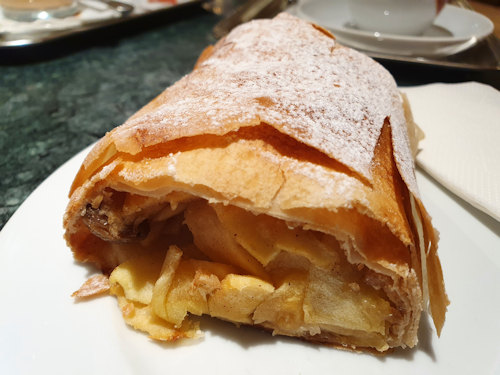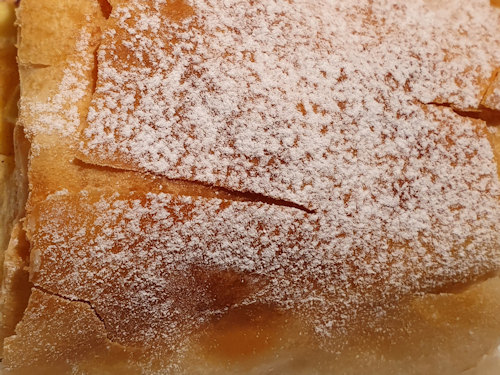
The first food mentioned in Maria’s list of favourite things in The Sound of Music and a mainstay of menus across Vienna: the Apfelstrudel or apple strudel.
- A classic Viennese dish
- Uses its own kind of pastry
- Numerous other kinds of strudel exist
- Book a culinary experience* in Vienna
- See also:
Apfelstrudel!

(A piece of apple strudel. Note the crisp flaky pastry and the dusting of icing sugar)
Open up practically any menu in a Viennese coffee house, Konditorei, or restaurant, and Apfelstrudel (apple strudel) lurks somewhere within.
You might find it suggested as an accompaniment for your coffee. Or perhaps it sits coquettishly among the dessert selections, waving a dollop of whipped cream to seal the deal.
In Vienna, apple strudel generally consists of baked rolled pastry with a filling consisting largely of (and this will shock you) cooking apples.
However, the ingredients typically also include sultanas, roasted breadcrumbs, sugar, and cinnamon. Along with apple varieties that tend to the sour side, this combination gives the strudel its distinctive flavour.
Traditionally, Apfelstrudel uses its own extremely thin pastry, which can be quite challenging to make, master and manipulate.
Many home bakers (well, me at least) tend to buy ready-to-use prepacked strudel pastry. Puff pastry makes a decent option, too, particularly for alternative strudel varieties (see below).
The history

(The Gerstner premises at Palais Todesco and Schönbrunn palace make a great strudel. The Vienna Pass includes a strudel show at the latter location)
The German word strudel means the swirls, eddies and whirlpools you get in water. The term finds metaphorical application, and its use to describe this apple-based delight stems from the appearance of the rolled up form when sliced.
Although closely associated with Austria and Vienna in particular, the strudel joins a list of classic dishes actually adopted and adapted from elsewhere (see, for example, the Schnitzel).
According to ministerial sources, strudel pastry first originated in North Africa. We can largely thank imperial conflicts for its presence in Vienna.
The Ottomans brought the pastry with them on their military forays into Habsburg territories. And all promising novelties in Habsburg territories inevitably found their way to Vienna for fine tuning to local tastes.
Not just apples

(Close up of the pastry)
Though English-speakers typically associate the term strudel with the apple strudel, our local cuisine has other varieties in both sweet and savoury form.
Apfelstrudel is the most famous example, of course, and the one normally meant when you simply ask for strudel.
You might, however, enjoy a main course of Spinatstrudel (with a spinach filling). At my home, we regularly eat Gemüsestrudel (with a broader vegetable filling) along with a sour cream sauce flavoured with chives.
If any meat eaters feel left out, well, you can also enjoy a Fleischstrudel (usually with a mincemeat filling).
And on the sweeter side of life…Topfenstrudel (quark filling) and Mohnstrudel (poppy seed filling) might, for example, join Apfelstrudel on the dessert menu.
For more desserts and pastries popular in Vienna, try this list.